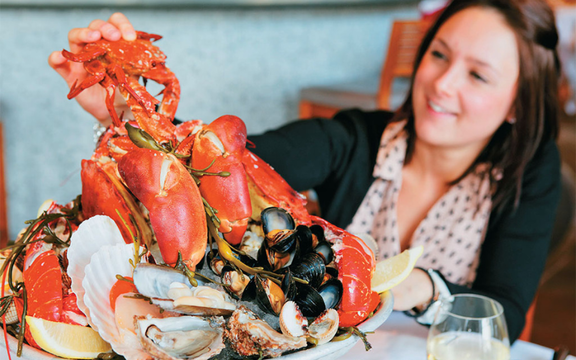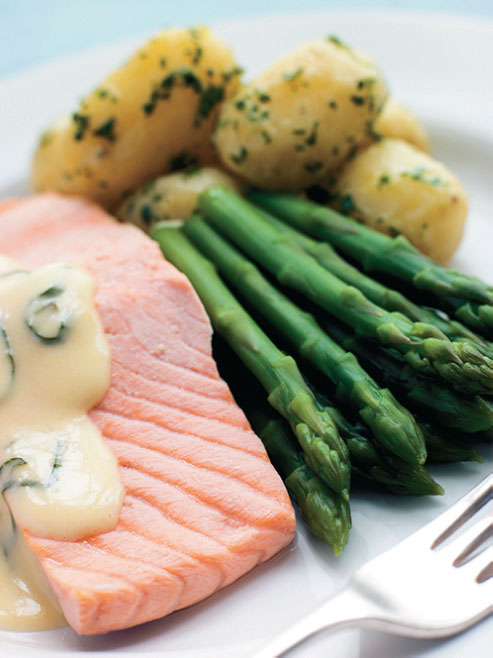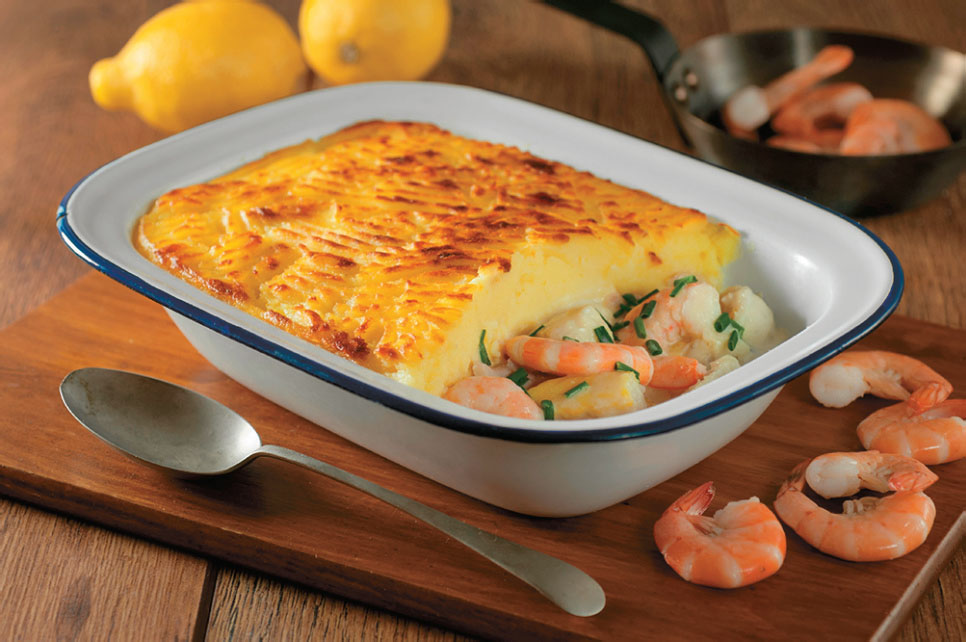
At Rick Stein’s famed seafood restaurant in Padstow, Cornwall, the sea’s bounty is presented with a distinctive flair.FRANZ-MARC FREI/CORBIS
Scores of different species of fish swim the silver seas surrounding Britain, and crustaceans find homes in the crannied coast.
No wonder fish and chips is the most popular national dish, traditionally made with cod or haddock, or nowadays sometimes with pollock. Fish and chips are inexpensive. At the other end of the price scale, delicious Dover sole is deservedly costly.
Usually, it’s grilled whole and ceremoniously separated into fillets by the waiter at the table. Trout and sea bass are also often served whole, eying diners from the plate—to the occasional alarm of visitors.
But Britain has a myriad of other fish specialty, many with strong regional connections. Cornwall is famous for pilchards and sardines, and restaurants in Newlyn—England’s largest fishing port—feature Cornish crab and monkfish, and make delectable fish pies. In South Wales, cockles are a favorite, and jellied eels are beloved by London Cockneys. Scotland is famous for salmon and, like the east coast of England, has a tradition of smoked fish.
Smoking developed in these regions as a way to preserve some of the vast catches of herring and other fish because drying—a method popular elsewhere—is unreliable in Britain’s damp climate.
Vast catches of any kind of fish are now rare, but Britain remains a land of fish and seafood lovers. Here are some quintessential specialties to look for.

Poached salmon teams nicely with asparagus and new potatoes
Kippers
Tawny-colored kippers are smoked herring. The fish are split, sometimes decapitated, brined then hot-smoked with oak. They originated on the northeast coast of England, and those of Craster in Northumberland and Manx kippers from the Isle of Man are especially famous because they are smoked by traditional methods. Since herring have annoying bones, kippers today are often sold as fillets. They are broiled or poached and served for breakfast or supper with a melting pat of butter. A Craster tea is a northeast specialty comprising two kipper fillets on a roll with a cup of tea. Kipper paté, made by mashing kippers with cream cheese and seasonings, is a popular appetizer.
Finnan Haddie
The school-bus yellow fish you see in British fish markets are smoked haddock. Their name comes from the village of Findon near Aberdeen, where fishermen preserved their haddock catch by smoking it over peat or green wood. Today the fish is dyed as well as smoked—hence its brilliant hue. Undyed finnan haddie are yellowy-beige and finer tasting. Finnan haddie poached in milk and topped with a poached egg is a classic supper dish. Other great finnan haddie classics include the Scottish soup cullen skink and kedgeree, an Anglo-Indian dish of smoked haddock, rice and hardboiled eggs flavored with onion and turmeric or curry powder. Kedgeree was a favorite Edwardian breakfast specialty, now most often served for supper.
Mackerel
In any seaside town in Britain, you will spot fishermen casting for mackerel, a common fish traditionally served fresh with gooseberry sauce. Other tart fruity sauces such as rhubarb and cranberry are occasionally used, their purpose being to offset the mackerel’s rich oiliness. Though lacking the long history of kippers, smoked mackerel now rival them in popularity. Producers highlight them with various flavorings, but herbs and cracked peppercorns are favorites. Smoked mackerel with a green salad is common pub-lunch fare, and smoked mackerel paté of ten appears on appetizer menus.
Salmon
Salmon are born in rivers, swim out to sea as two-year-olds, and return to their native streams two to four years later, well-fed and eager to reach the gravelly spawning grounds in the headwaters where they hatched. Catching them as they fight their way upstream is a thrilling sport on several rivers, most famously Scotland’s River Dee. Farther south, anglers “chase the silver”—their term for salmon fishing—on the Wye and Dee that flow through Wales to form the border with England. But except in such areas, salmon in Britain comes from farms.
The most popular summer party dish is cold poached salmon cooked whole or as a filleted side and served with sliced cucumbers and new potatoes. Salmon also sometimes replaces finnan haddie in kedgeree. Smoked salmon is popular as well. It originated in Scotland, and for long lacked prestige because it was made by poor fishermen to tide them over the winter. But Queen Victoria loved all things Scottish, and she is often credited with making it more widely known—at least among the wealthy. Today salmon farming has brought it in general reach. Smoked salmon sandwiches are a lunchtime favorite, smoked salmon appetizers grace restaurant menus, and smoked salmon adds a burst of flavor in fishcakes, salads and pasta dishes.

Fish pie has a pedestrian name, but ‘tis a dish for the gods
Fish Pie
Fish pie is a popular family dish all over Britain. No pastry is involved. Mashed potatoes provide the topping for a mixture of fish in a parsley-flavored sauce. Any combination of fish that offers some contrast is fine. Salmon, cod or haddock, with finnan haddie for a smoky flavor or shrimp for its contrasting texture is good. In South Wales, a classic variation teams cockles with bacon, and in Cornwall cream is sometimes used instead of white sauce.
For the filling:
1 pound haddock (or cod or hake)
1/2 pound salmon
1/4 pound cooked peeled shrimp or finnan haddie Salt and white pepper to taste
3/4 cup cooked fresh or defrosted frozen peas
11/2 cups warmed milk
2 tablespoons chopped parsley
2 tablespoons butter
2 tablespoons all-purpose flour
About 4 cups mashed potatoes
(made from 2 pounds potatoes &1/4 cup milk)
1 egg, beaten
Preheat the oven to 400 degrees and lightly grease a11/2-quart baking dish. Cut all the fish in bite-size pieces, discarding the skin. Leave the shrimp whole. Distribute the fish and shrimp in the prepared dish and season lightly with salt and pepper Scatter the peas on top.
Melt the butter in a saucepan, and off the heat stir in the flour to form a paste. Stir 1/4 cup of the milk into it. When it is smooth return it to low heat and stir in another 1/4 cup of milk. Gradually stir in the rest of the milk. Bring to simmering point, stirring all the time until it thickens. Add salt and pepper to taste. Simmer for 3-4 minutes. Stir in the chopped parsley, then pour the hot sauce over the fish.
Spread the mashed potatoes on top, making sure to cover the fish and sauce completely. Rough up the surface with a fork. Brush the potatoes generously with the beaten egg. Bake for 25-30 minutes or until golden. Serves 4-6.
Crustaceans
Crustaceans are beloved in Britain, especially in seaside resorts, where outdoor kiosks sell small portions for eating with a plastic fork while strolling along the promenade. Usually, cockles and mussels at these outlets are pickled in malt vinegar. Oysters are more expensive, though once so plentiful that the invading Romans were amazed at their abundance and so cheap that the Victorian working-class could eat them as snacks. Whits-table, Kent, retains its ancient fame as the place for oysters, celebrating its beloved bivalve with an Oyster Festival and a Blessing of the Waters in late July.
Whitstable's oysters are now usually farmed. Similarly, mussels, though common on seaside rocks, are also farmed, with excellent examples coming from Conway in North Wales. Crabs and lobsters also come from the Welsh coast and several other regions. Most lobsters are exported and so are many crabs, but crabs are widely available in British fishmongers. Those of Cornwall and Cromer in East Anglia are especially prized. A dressed crab is a favorite treat. The meat is picked from a cooked crab then rearranged in the shell, brown meat on the bottom, the white and claw meat on top. Shrimp are also popular. Among the sweetest and tastiest are the little brown shrimp from Morecombe Bay in the northwest of England. One classic preparation is to pack them in ramekins and cover them with clarified butter. These potted shrimp used to be a breakfast specialty, but now more often occur as an appetizer. Then there’s shrimp cocktail, served in Britain with a creamy pale-pink Marie-Rose sauce. There’s prawn cocktail, too, and prawn sandwiches and prawn curry. Prawns are not a different sea creature: they are simply large shrimp, mostly now imported from Asia. Dublin Bay prawns are something else again. With their lobster-like claws and meaty tails, they are better known by their French name: langoustines.





Comments